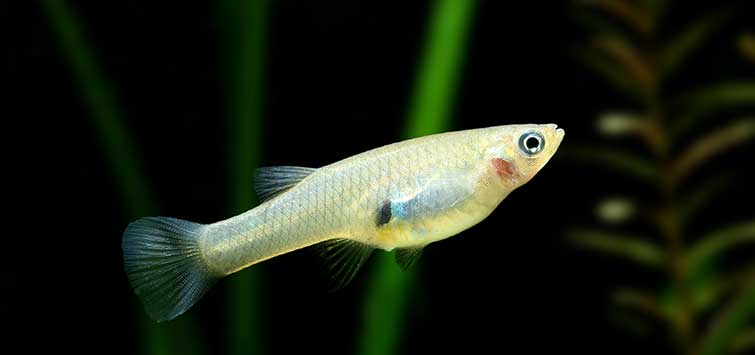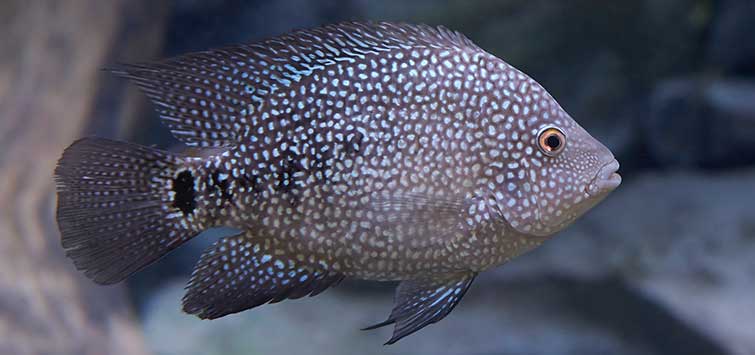Tres Amigos: Three Texas Livebearing Fishes
Author: Bill Allen
In honor of the ALA Convention's Texas locale this year, a lifelong fishkeeper and ALA luminary discusses three native American livebearers that are found in the Lone Star
The great state of Texas is home to many things. Tex-Mex cooking, Willie Nelson’s music, and a beer named for the Lone Star State are among my personal favorites. I’m thrilled that San Antonio will be the site of the 2008 American Livebearer Association (ALA) Convention May 1–4.
But Texas is also the native home of several species of livebearers. Although most of the poeciliids, or livebearing toothcarps, hail from further south in Central and South America and the Caribbean islands, a few have ventured further north and call the southern United States, including Texas, their home.
Gambusia affinis
By far the most common of these is Gambusia affinis, the common mosquitofish. Its natural range is from Southern Illinois southward and from the New Jersey Atlantic coast to Texas, but its range has been extended considerably (Douglas, 1974). This fish can now be found virtually all over the world in temperate climates, even in Iraq and Afghanistan—this is because people have introduced it in many far-away lands because of its prodigious appetite for mosquito larvae. G. affinis is a plain gray fish easily mistaken for a very common-looking guppy. But the trained eye can readily tell the difference—whereas even the common male guppy will sport at least a tiny bit of color, no markings will be found on a male G. affinis, except for a black “teardrop” below the eye (Page, 1991). Also, the male G. affinis has a much longer gonopodium (modified anal fin) than a guppy.
Because of their drab colors (and nasty, fin-nipping disposition) they are infrequently kept by American aquarists. You might even find them in your local fish store’s feeder tank, where you might think that they are guppies! In fact, as a teenager I caught and sold them by the thousands to a local fish store as feeders, for a nickel apiece. But if you wanted to try to keep these little natives, there’s nothing to stop you. A well-planted 10-gallon tank will easily hold a small colony, and you don’t even have to provide a heater—room temperature or even the chills of an indoor winter will not bother them, only slow down their breeding.
Protected Relatives
There are several other species of the genus Gambusia that call Texas home. Included in these are Gambusia nobilis, G. gaigei, G. geiseri, and G. heterochir. In contrast to the widespread G. affinis, these fish mostly have extremely limited ranges, often a single body of water. Many are so rare that they are protected by the Endangered Species Act, so keeping them is out of the question for the home aquarist (Page, 1991). In fact, at least one Texas Gambusia species is not with us at all anymore.
Gambusia amistadensis was wiped out when its habitat, the Goodenough Spring near Del Rio, Texas, was dammed and transformed into Lake Amistad. The poor little fish couldn’t adapt and is now extinct. Isn’t it ironic that one of the most common species of fish, spread throughout practically the entire globe, has close relations that are no longer with us or hanging onto their place on Earth by a mere thread?
Poecilia latipinna
We’ll move now from one of the world’s plainest livebearers to one of the most spectacular. If you have never seen a school of sailfin mollies being shepherded by a large alpha male, you should! The male flashes blue and gold and spreads his fins to the breaking point as he simultaneously impresses the ladies and intimidates other males. I’ve seen this in the shallow waters of the San Antonio River at the famous San Antonio River Walk. At the same time, I’ve seen nesting Texas cichlids Herichthys cyanoguttatus chasing the mollies away from their nests.
Many aquarists are familiar with mollies from Florida, but not many realize that the range of Poecilia latipinna extends into the great state of Texas (Page, 1991). Almost no one is more familiar with Texas mollies than Charles Clapsaddle of Goliad, Texas, near San Antonio. He collects sailfin mollies from nearby Coleto Creek and crosses them with some of the beautiful domesticated strains of mollies to produce the huge mollies that dominate the molly classes of the ALA Convention show every year. A tour of his facility and a collecting trip at Coleto Creek are part of the activities scheduled for the convention.
Despite the fact that they are often found in fetid ditches with foul water and in baking temperatures, good sailfin mollies are quite a challenge to keep in captivity. If you wish to try, give them plenty of room, lots of water changes, and frequent feedings of food with a large amount of vegetable material. They do particularly well in outdoor ponds; this is probably the best option if you live in a fairly mild climate.
Heterandria formosa
A large number of Louisiana natives left their homes and relocated westward following the devastation of hurricanes Katrina and Rita in 2005. A small livebearer may have joined this migration. The range of Heterandria formosa is normally not given to include Texas, but in recent years some individuals of the species have popped up, at first on the west side of the Sabine River, which separates Texas from Louisiana (Page, 1991). Lately some specimens have been procured in Winnie, Texas, outside of Houston, by native-fish buff and Tyler, Texas resident Vincent Brach.
It’s possible that these fish have been in Texas for a long time, but had not been noticed. In their native habitat they stay hidden in dense underwater vegetation and are seldom spotted from the surface. In fact, every time I’ve collected them, I’ve simply passed a dipnet through heavy vegetation and searched through the muck for tiny gold-brown bodies with a darker longitudinal stripe. Mr. Brach told me that he caught many females but very few males; I told him that the males are so tiny that they probably either slipped through his net or escaped his notice. These fish are unique in that they are so tiny that the female cannot hold a large brood of youngsters in her belly, as do most livebearers. So instead, she produces babies in an assembly-line fashion—youngsters in various stages of development grow almost continuously inside her and are delivered, a few at a time, over a period of several days (Wischnath, 1993).
Heterandria formosa is sometimes also called the mosquitofish, and thus is easily confused with the previously mentioned Gambusia affinis—but H. formosa is also called the least killifish. It is quite different in appearance, but what sets these apart from G. affinis is their size. Females seldom top 3 cm (a little more than an inch), but they absolutely dwarf their miniscule mates; the males are about 2 cm (less than an inch) but are also considerably slimmer. Keeping these tiny fish is easy and a real treat. They are ideally suited to a mini desktop tank. In fact, they’ll easily get lost in the huge expanses of a 10-gallon tank.
Provide them with some vegetation—Java moss and hornwort (Ceratophyllum) are great—and a tiny amount of food, and they’ll do fine. You can forget about a heater and probably won’t really need filtration either. I’ve had a colony in a 2½-gallon tank of fish collected from Bayou Lacombe, Louisiana going since shortly after Hurricane Katrina, and every few months I thin them out by giving a few away or selling them. Of course, because they are so tiny they do best kept by themselves, but I have had limited success keeping them as tankmates with Endler’s livebearers.
ALA in Texas
Texas will really be a hotbed for livebearers in May 2008 at the American Livebearer Association Convention, but as you can see, Texas has had a lively native population of livebearers for many years. I wonder if they like Willie Nelson, too....
References
Douglas, N. H. 1974. Freshwater Fishes of Louisiana. Claitor’s Publishing, Baton Rouge, LA.
Page, L. M., and B. M. Burr. 1991. A Field Guide to Freshwater Fishes. Houghton Mifflin Company, New York, NY. pp. 235–240.
Wischnath, Lothar. 1993. Atlas of Livebearers of the World. T.F.H. Publications, Neptune City, NJ. pp. 117–118.
www.gambusia.net
www.goliadfarms.com D
See the full article on TFH Digital http://www.tfhdigital.com/tfh/200805/#pg102

.png?h=595&iar=0&w=2781&hash=5FD5E69473BCC22199FBFA2FB71B6033)



